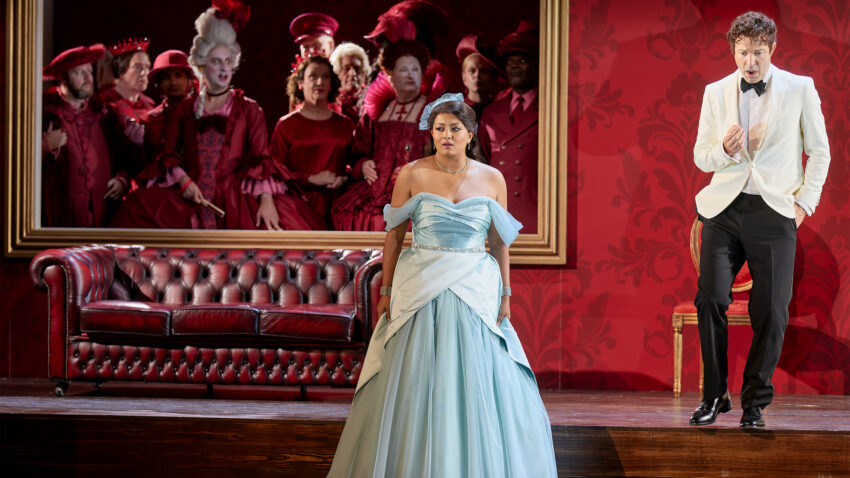Rossini's La Cenerentola (Cinderella)
Rossini based his opera on Charles Perrault‘s popular version of the fairy tale. However, he makes several changes to the story.
He changes the gender of several key characters. Cinderella, or Angelina as he names her in his opera, has a step-father – Don Magnifico – instead of a stepmother. There is no fairy godmother but the Prince has a tutor called Alidoro who helps get Cinderella to the ball.
There is no slipper but a bracelet to prove Cinderella’s identity. Many of these changes too place to remove the magical elements from the story so that the opera was easier to stage.

Antonín Dvořák’s Rusalka
Although the libretto from Dvořák’s greatest opera draws from a number of inspirations, the most obvious example is that of Hans Christian Andersen’s The Little Mermaid.
As with the original fairy tale, the opera isn’t the happy story you know from the famous 1989 Disney adaptation.
The water-nymph Rusalka is turned into a human so that she can earn the love of the Prince, on two conditions: she must always remain silent and he must always remain true to her. Although the prince and Rusalka fall in love, their happiness is soon brought to an end when the Prince is convinced to reject her. The crushed Rusalka breaks her vow to tell the prince she will be damned by the witch’s curse unless he kisses her, but that would cost him is life. They kiss; the prince dies and Rusalka returns to the water.

Engelbert Humperdinck’s Hansel and Gretel
The original tale of Hansel and Gretel, as told by the Brothers Grimm, is far more sinister than you probably remember.
The tale begins when Hansel and Gretel overhear their Stepmother plotting to take the children in the woods to die. Trying to outwit their parents, Hansel leaves a trail of breadcrumbs behind, but soon discovers that birds have eaten them, leaving the children stranded in the forest. The children stumble across the gingerbread house of an evil witch who captures the pair and begins to fatten them up to eat. Gretel finally manages to kill the witch by pushing her in an oven.
Composer Humperdinck and librettist Adelheid Wette wanted their opera version of Hansel and Gretel (Hänsel und Gretel) to be family friendly so adapted some of the original story to do so. The children aren’t left in the woods to die; they are innocently lost while picking strawberries. There is also the addition of the fairy tale characters, the Sandman and the Dew fairy.

Massenet’s Cinderella (Cendrillon)
Massenet based his opera on Charles Perrault‘s popular version of the fairy tale. The popularity of Perrault’s tale was due in part to his additions to story, including the fairy godmother, the pumpkin carriage and the glass slipper.
It’s this version of the story that Rodgers and Hammerstein used as the inspiration for their 1957 musical Cinderella. It was written for television where actress Julie Andrews played the title role. It was remade 40 years later with a mixed race cast starring Brandy as Cinderella and Whitney Houston as the Fairy Godmother.
The opera’s story follows closely to one many of us are familiar with. Cendrillon (Cinderella) must be back from the ball before midnight. Leaving the ball hastily, she leaves behind a glass slipper. The Prince summons all the maidens from the land to try and the glass slipper so he can be reunited with the girl he fell in love with. The Prince finds Cinderella and everyone rejoices, hailing her as the future queen.
Perrault is also well known for his versions of the famous fairy tales; Little Red Riding hood (Le Petit Chaperon Rouge), Puss in Boots (Le Chat Botté) and The Sleeping Beauty (La Belle au bois Dormant).

Puccini’s Turandot
In 1911 Puccini saw Gozzi’s play, Turandot, based on a story from François Pétis de la Croix’s The Thousand and One Days (Les Mille et un jours). He decided that the passionate and dramatic tale was perfectly suited for operatic treatment. Both the play and the opera, Turandot are loosely based on an ancient Persian fairy tale, The Seven Beauties (Haft Peykar), an epic poem by 12th-century Persian poet Nizami. The opera features one of the world’s most famous tenor arias, Nessun Dorma.
The operatic version of the tale is set in China, where the evil Princess Turandot has sworn no man shall marry her unless he can correctly answer three riddles. Prince Calaf, who has fallen for Turandot, solves the riddles, but wants to set the Princess her own challenge. He states that he will willingly die if she can guess his real name. We find out at the end of the opera, that name is Love.
Unfortunately, the great Italian composer wouldn’t live to see his final opera on the stage. When he died in 1924, Puccini had left much of the third Act incomplete. He is said to have remarked ‘my opera will be staged incomplete and then someone will come on to the stage and say to the public: ‘At this point the composer died’. On the opera’s opening night, at La Scala, Milan (1926), the conductor has been said to have done just that.



